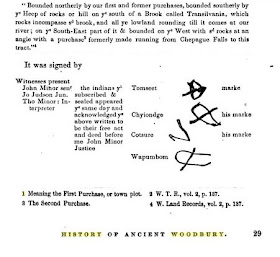CHAPTER I. - STRATFORD INDIANS.
"INDIAN history, under whatever circumstances found, excites a melancholy sympathy, which partakes of extreme loneliness as if one were lost in an interminable wilderness from which there could be no escape by the ingenuity or power of man. As we pass over the site of their ancient wigwams, although not a stick or stone is left to mark the place, we seem to be traveling amid the ruins of some ancient Persian or Egyptian city, long celebrated for its beauty and magnificence and from which, although the glory has all faded or crumbled to dust, we hesitate to depart, as though expecting still to see the forms of the long-departed coming forth to newness of life, to exhibit the wonders of ancient days. Occasionally we discover about traditional localities some stone implement, arrow-head, pestle or axe, that seems as a spirit resurrected by enchantment to portray the marvelous, wild life that wrought it, for the severest needs of earth, which is like the recovery of some long-lost painting of kingly banquet or national pride and glory. The hatchet, although of stone, was the Indian's ensign of renown; the bow and arrow, his national flag of wild but unconquerable liberty, and his tent, because it was not immovable, declared an inheritance in a vast continent rather than a few circumscribed acres of walled distributions.
Sometimes the rolling waters of a mighty river, or the heights of immense mountain ranges barred his progress for a time, but no mountain was too high and no valley too low for the unwearied feet of the Red man in the greatness of his freedom and the inexhaustible resources of his physical strength. Nothing but the mighty ocean ever stayed his wandering footsteps, until the white man took possession of the rocky and sandy shores of the Algonkin country, afterwards called New England; when "the poor Indian" fled to the inland wilderness as if pursued by a devastating pestilence; nor has he yet, after nearly three hundred years, found a sure resting place. To him the shores of Long Island Sound were an enchanted country, in the abundance it gave to supply his wants, and the beauty of its climate and scenery reminding him of the native tropical clime of his ancestors.
Here on these shores he had dwelt many ages, when the glittering sails of the white man came bearing the pilgrim planters to their new life of freedom. In the winter many of them had retired to the sheltered valleys of the inland wilderness, where they secured their daily food by the hunter's sport, and then in the spring they returned to their old seaside haunts, just as their white successors now, in the same season of the year, flee from the hot breath of the inland valleys to the cool breezes of the New England coast. These "children of the wilderness" have been called "Red men," "wild Indians," "savage beasts," but with all, they have exhibited a manliness of character and rectitude of life, according to the instructions received, that leaves no room for boasting by those who now inhabit the same beautiful country. To these untutored inhabitants the pilgrim immigrants were rather unceremoniously introduced, and to them in turn they gave a cordial welcome, not knowing what the final result would be. And now, after the lapse of ages, the pen of the historian is importuned for some memorial record, which, although inadequate to the object sought, shall be as a brief epitaph to commemorate the greatness of those, of whom there is now nothing but ashes and fragments left…”
Orcutt the Historian’s words do sometimes excite in me a melancholy sympathy and an extreme loneliness, but not about an interminable wilderness – and I flat out disagree that "not a stone is left to mark the place," traveling amid the "ruins" as I sometimes do.
Box Turtle Effigy (1996)
I still see the forms of the long departed and they indeed do exhibit the wonders of the ancient days that I "discover" as I ramble about the traditional localities, some stone or collection of stones that really does seem as a spirit resurrected by enchantment to portray the marvelous – and it extends outward on a vast continent.
The sad part is that most people see what I am seeing as a few circumscribed acres of walled distributions, at the most just 300 or so years old.
It’s similar to seeing Treaties made up that river from Stratford CT referred to and used as land deeds, English Law superseding the Laws of Indigenous Traditions.
I look at that phrase “a few circumscribed acres of walled distributions” and I think I see why those Indigenous Walls just didn’t make it into the Historic Record, why those fence laws – and wooden rail fences - suddenly sprung up as Indigenous Lands were appropriated. The English Fence Laws defined owned property and those ancient walls just didn’t count, no matter how long they had actually been there, no matter if they were part of the Cultural Landscape, mirroring the Spirit World, built to resemble the Great Serpent who connected the three-tiered world of Sky Above, Underworld Below, and the Earth We Walk Upon.
(Illustration from Jannie Loubser - The Socio-Economic and Ritual Contexts of Petroglyph Boulders in the Southeastern United States)
And of course those walls below the rails were just refuse piles of field cleared stone, tossed haphazardly from the field, dumped from a stone boat sledge or stacked up for later use or some other silly sort of hypothesis that erases the Indigenous hands and minds from the landscape, ethnically cleansing away cultures other than English or European or American, if you will...
Woodbury Treaties












No comments:
Post a Comment